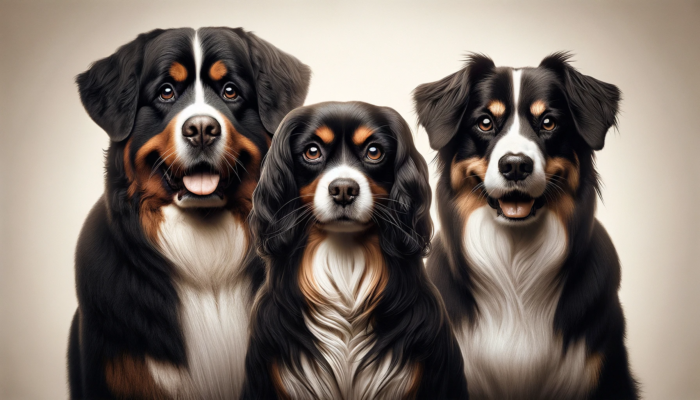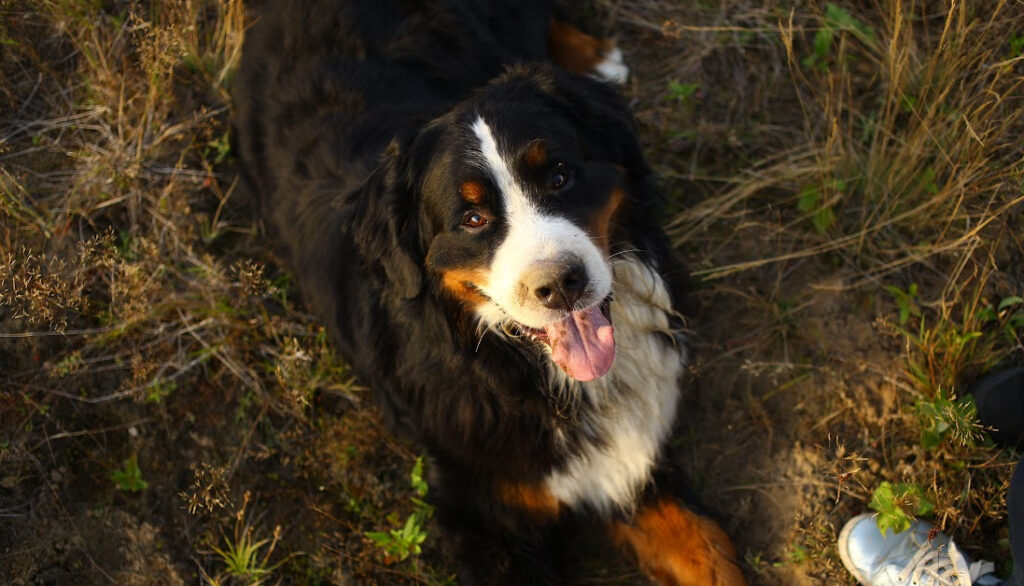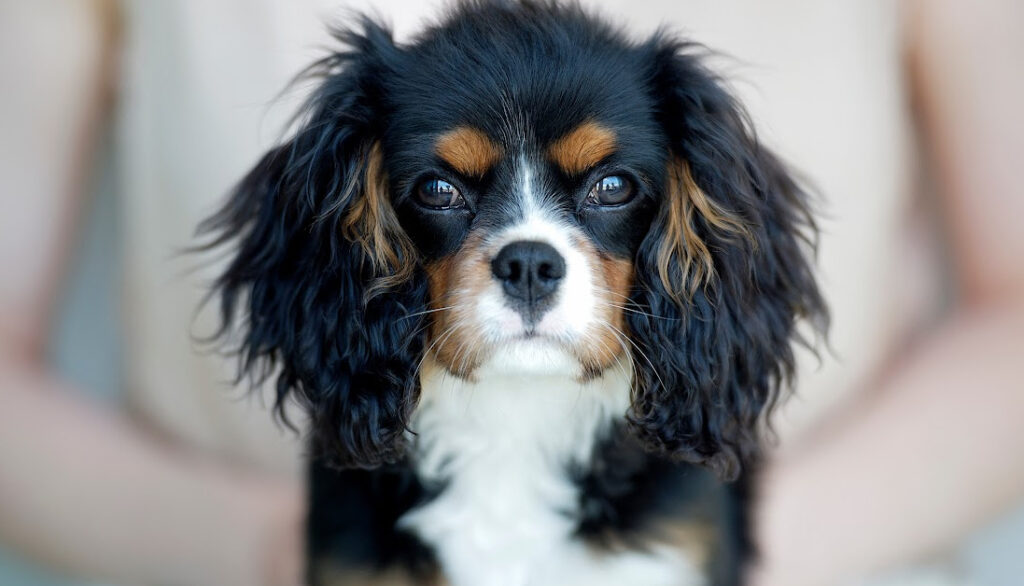Hello there, fellow dog lover! If you’re drawn towards pooches with striking black, brown, and white coats, you’re not alone. These tri-color canines have an undeniable appeal, thanks to their unique and vibrant fur. But, have you ever wondered why some dogs boast these three enchanting colors? Well, it’s all down to genetics and a little dash of breed history.

Let’s dive a bit deeper, shall we? Tri-color coat patterns in dogs are a result of specific genes that influence pigmentation. Essentially, these genes regulate the distribution of eumelanin (black/brown pigment) and pheomelanin (red/yellow pigment) in a dog’s fur, resulting in the beautiful black, brown, and white colorations we adore. But, don’t let the science bore you! The result is a canine coat that’s nothing short of a work of art.
Moving on to a bit of history. The development of tri-color breeds is attributed to hundreds, if not thousands, of years of selective breeding. Certain breeds were favored for their distinctive tri-color coats, often for reasons ranging from camouflage during hunting, to simple aesthetic preference. Today, these breeds feature prominently in show rings and family homes alike, their historical significance adding to their charm.
What’s more, tri-color dogs come in all shapes and sizes, from tiny small tri-color breeds like the Papillon to towering large tri-color breeds like the Bernese Mountain Dog. Plus, their diverse lineages mean that they boast a range of characteristics, temperaments, and care needs. Some may be sprightly and enthusiastic, while others are gentle giants. But one thing’s for sure: owning a tri-color dog is a rewarding experience, filled with lots of love, loyalty, and vibrant hues!
So, join me on this colorful journey as we explore the wonderful world of black, brown, and white dog breeds. Whether you’re looking to adopt or simply curious, this guide is sure to satisfy your thirst for canine trivia. Let’s embark on a pawsome adventure, shall we?

Black Brown White Dog Breeds: The Classic Tri-Color Canines You’ll Love
History and Origin of Tri-Color Breeds
Dive into a time machine with me as we journey through the captivating history and origin of tri-color dog breeds. These canines, adorned with coats of black, brown, and white, carry not just beauty but fascinating stories woven into their fur.
The Evolution of Tri-Coloration in Dogs
The tri-coloration in dogs we admire today is not a product of chance, but a significant evolutionary development. It’s all about genetics and the interplay of multiple genes dictating color patterns. A dog’s coat color is primarily influenced by two pigments – eumelanin (black) and phaeomelanin (red or yellow). These pigments can be modified by various genes, resulting in a spectrum of colors and patterns, including our beloved tri-color.
The black, brown, and white coloration likely evolved due to natural selection and adaptation, with some breeds being favored due to their camouflaging benefits or their association with specific traits like strength or loyalty. But more than that, these fascinating color variations highlight the immense genetic diversity within the canine species.
Historical Significance of Tri-Color Breeds
The historical significance of tri-color dog breeds can be traced back to various cultures and epochs. From ancient cave paintings to medieval tapestries, dogs with black, brown, and white coats have been depicted as companions, hunters, and symbols of status.
In many cultures, the tri-color coat was associated with good luck and protection. For instance, in Celtic mythology, dogs with tri-color coats were considered sacred and thought to bring fortune.
Certain breeds, like the Basset Hound, were favored by French royalty for their distinct tri-color markings. These dogs were not just pets but revered hunting companions, their striking colors offering a stark contrast against the green fields, making them easily identifiable.
Meanwhile, the Bernese Mountain Dog, known for its tri-color coat, has a long history of working on Swiss farms, showcasing the blend of beauty and functionality these dogs embody.
To own a tri-color dog is to own a piece of history, a living testament to the long-standing bond between humans and dogs. Understanding the rich history of these tri-color breeds enhances our appreciation for them and reminds us of the diversity and adaptability inherent in the canine species.
As you embark on the journey of choosing a black, brown, and white dog breed, remember, you’re not just choosing a pet. You’re choosing a companion steeped in rich history, evolutionary marvel, and genetic diversity. So, whether you’re drawn to the lively Beagle, the hardworking Australian Shepherd, or the majestic Bernese Mountain Dog, know that your tri-color friend is a classic canine, a testament to the enduring bond between humans and dogs.
Conclusion
In the end, choosing a dog breed is about more than just aesthetics. It’s about understanding and appreciating the history, genetics, and unique traits that each breed brings. A tri-color dog is not just a beautiful pet, but a fascinating tapestry of history and evolution.
Popular Black, Brown, and White Dog Breeds
Let’s dive into the fascinating world of black brown white dog breeds. These tri-color pups are cherished for their distinctive markings, adding an extra flair to their charming personalities. Some breeds you may be familiar with but there are also those less known, each with their own appeal.
Characteristics of Tri-Color Breeds
Tri-color dogs are characterized by a coat that displays three distinct colors: black, brown, and white. This striking combination is present in a variety of breeds, ranging from small lap dogs to large working breeds. Individual characteristics can vary greatly, but these dogs often share common traits, such as being energetic, intelligent, and affectionate.
Here are some of the popular breeds that often come in black, brown, and white:
- Bernese Mountain Dog: A large and hardworking breed, known for its friendly disposition and striking black, brown, and white coat. They’re intelligent and excellent with kids, making them great family pets.
- Beagle: This breed is well-known for its distinctive tri-color patterning. Beagles are small to medium-sized dogs that are energetic, playful, and friendly.
- Papillon: This small breed often features a tri-color coat of white, sable, and black. They’re energetic, intelligent, and very friendly.
- Shetland Sheepdog: Often sporting a beautiful black, brown, and white coat, these dogs are loyal, intelligent, and very trainable.
Benefits of Owning a Tri-Color Dog
Aside from their striking good looks, there are several benefits to owning a black brown white dog breed. The tri-color coat is more than just a beautiful feature, it also serves as a conversation starter with fellow dog lovers. You’ll find that your tri-color dog will garner a lot of attention during walks in the park or visits to the pet store.
Many of the tri-color breeds are also known for their high intelligence and affinity for training. Breeds such as the Bernese Mountain Dog and the Shetland Sheepdog are not only stunning to look at but are also highly trainable and great work dogs. Their intellect, combined with their love for physical and mental stimulation, makes them excellent companions for active owners.
Another great benefit of these breeds is their versatility. They come in a range of sizes, from small breeds like the Papillon to large breeds like the Bernese Mountain Dog. This diversity makes it easy for prospective dog owners to find a tri-color breed that fits their lifestyle, whether they live in a small apartment or a large house with a yard.
In short, owning a black, brown, and white dog breed not only gives you a beautiful, distinctive pet but also a loyal, intelligent, and versatile friend. These breeds are bound to bring joy, companionship, and a splash of color to your life!
List of Black, Brown, and White Dog Breeds
Small Tri-Color Breeds
Tri-color dogs come in all shapes and sizes, and if you’re specifically interested in smaller breeds, you’re in luck! Here are a few small black, brown, and white dog breeds that might just steal your heart:
- – Beagle: Known for their playful and friendly nature, Beagles are small hound dogs with a keen sense of smell. They typically have a short coat with black, brown, and white coloration.
- – Cavalier King Charles Spaniel: These dogs are small, affectionate, and great with families. They have a beautiful, silky coat and often come in a combination of black, brown, and white.
- – Shih Tzu: These adorable little dogs are often tri-color and have a long, flowing coat. They’re known for being friendly and good with kids.
- – Papillon: Papillons are small, intelligent dogs with large, butterfly-like ears. Their coat is usually white with patches of black and brown.
- – Boston Terrier: Known as the “American Gentleman,” these dogs have a distinct black and white coat with possible brown highlights. They’re friendly and great with families.
Large Tri-Color Breeds
If you’re interested in a larger dog with this classic coloration, there are plenty of breeds to choose from. Here are some large black, brown, and white dog breeds:
- – Collie: These large dogs are known for their intelligence and agility. They often have long, lush coats that come in a variety of colors, including black, brown, and white.
- – German Shepherd: German Shepherds are large, intelligent, and loyal dogs. While they are most commonly known for their black and tan color, they can also come in a tri-color pattern.
- – Bernese Mountain Dog: These dogs are large, friendly, and great with families. They have a thick, silky coat that is typically black, brown, and white.
- – Greater Swiss Mountain Dog: Similar to Bernese Mountain Dogs, these dogs are large, friendly, and have a tri-color coat. They are great workers and are known for their strength and agility.
- – English Setter: These dogs are large, friendly, and have a unique speckled coat. They often come in a combination of black, brown, and white.
Whether you prefer smaller or larger breeds, there are plenty of black, brown, and white dog breeds to choose from. Each breed has its own unique characteristics and traits, so be sure to research each one to find the perfect tri-color dog for you!

Health and Care for Tri-Color Dog Breeds
Common Health Issues in Tri-Color Dogs
Just like any other dog breed, black, brown, and white dog breeds can be prone to certain health issues. It’s important to note, however, that the color of a dog’s coat does not directly relate to its health. Instead, the breed and genetics play a larger role in determining potential health risks.
For instance, Beagles, a popular tri-color breed, are known to be susceptible to health issues such as hip dysplasia, epilepsy, and hypothyroidism. On the other hand, Bernese Mountain Dogs, another tri-color breed, can be prone to cancer, hip dysplasia, and progressive retinal atrophy.
It’s essential to research the specific breed you’re interested in to understand their potential health risks. Regular vet check-ups are also crucial to ensure your furry friend stays healthy and happy.
Grooming and Maintenance Tips for Tri-Color Coats
Taking care of a tri-color dog’s coat can be a rewarding task. Their stunning coat colors make grooming a visual treat. Here are some tips to help keep your tri-color dog’s coat in top shape:
- – Regular Brushing: Brushing your dog’s coat frequently will help distribute natural oils, remove dead hair, and prevent matting. The frequency might vary depending on the breed’s coat type. Short-haired breeds like Dachshunds may only need weekly brushing, while long-haired breeds like Bernese Mountain Dogs may require daily care.
- – Bathing: Bath your dog regularly, but not too often as it can strip the natural oils from their skin and fur, leading to dryness and irritation. The frequency of baths will depend on your dog’s lifestyle and breed.
- – Use the Right Products: Always use dog-friendly grooming products. Human shampoos and conditioners can disrupt the pH balance of your dog’s skin, causing irritation or dryness.
- – Regular Check-ups: Regularly check your dog’s skin and coat for any signs of fleas, ticks, dry patches, or infections. Early detection can prevent more serious issues down the line.
- – Professional Grooming: Depending on your dog’s breed, they may benefit from professional grooming services. Professional groomers have the tools and knowledge to handle the grooming needs of different breeds.
Remember, a well-groomed coat not only looks good but also contributes to your dog’s overall health. So, be sure to invest time in maintaining your tri-color dog’s beautiful coat.
In the end, owning a black brown white dog breed comes with its own set of responsibilities. But with proper care and regular health checks, you can ensure your tri-color companion lives a long, healthy life.
Training and Temperament of Tri-Color Dogs
Training any dog breed requires patience, consistency, and understanding, and black, brown, and white dog breeds are no exception. However, there are some unique behavioral traits and training tips you might want to consider for these tricolored canines.
Behavioral Traits of Tri-Color Breeds
Just like humans, dogs have their own individual personalities. However, certain behavioral characteristics often run common among specific breeds. It’s important to understand that the color of a dog’s coat doesn’t necessarily affect its behavior. But, since we’re looking at breeds that typically come in black, brown, and white, let’s delve into the common behavioral traits you might encounter.
For instance, Beagles, known for their tricolor coats, are generally friendly and curious. They are great with kids and have an innate sense for tracking scents, which sometimes can lead them astray.
The Border Collie, another popular black, brown and white breed, is highly energetic, intelligent, and needs lots of mental and physical stimulation every day. They excel in obedience and agility training, and thrive when given tasks to complete.
The Bernese Mountain Dog is yet another tricolor breed. They are typically gentle, easygoing, and good-natured dogs that are great with families and other pets. However, they are a large breed that requires consistent training to prevent unwanted behaviors.
Training Tips for Tri-Color Canines
Now let’s look at some general training tips that can apply to black, brown and white dog breeds.
- Begin Training Early: Start training your dog as early as possible. Puppies are more open to learning and can grasp new commands quickly.
- Be Consistent: Consistency is key in dog training. Use the same commands and reward system to avoid confusing your dog.
- Positive Reinforcement: Reward good behavior with treats, praise, or playtime. This encourages your dog to repeat the action.
- Patience and Understanding: Understand that learning takes time. Don’t get frustrated if your dog doesn’t get a command right away.
- Socialization: Socialize your dog with other pets and people. This helps your dog become more comfortable in different environments and can prevent fear-based behaviors.
Remember, each dog is unique, and what works for one might not work for another. It’s all about understanding your dog’s needs and responding accordingly. Training a dog can be a rewarding experience, offering an opportunity to build a strong bond between you and your furry friend. No matter the color of their coat, all dogs are capable of offering unconditional love and companionship.

The Best Environment for Tri-Color Dogs
Tri-color dogs, with their striking black, brown, and white coats, have unique needs that potential dog owners should consider. Understanding these needs will help you create the best possible environment for your tri-color canine companion.
Ideal Living Conditions for Tri-Color Breeds
Tri-color breeds range from small dogs like the Papillon to larger breeds like the Bernese Mountain Dog. Their ideal living conditions largely depend on their size, breed characteristics, and temperament.
Small tri-color breeds like the Cavalier King Charles Spaniel or Beagle are adaptable and can thrive in apartments or smaller living spaces as long as they get ample exercise. However, larger breeds like the Bernese Mountain Dog or the Australian Shepherd need more space to move around. These breeds will thrive in homes with large yards where they can burn off energy.
Regardless of size, all tri-color breeds need a safe and secure environment. Safety measures such as secure fencing and dog-safe plants are important to ensure their well-being. Since many tri-color breeds have thick coats, ensure your home has proper ventilation or air conditioning to keep them comfortable during warmer months.
Key Points to Remember:
- * Small tri-color breeds can adapt to apartments or smaller spaces.
- * Larger breeds need more space to move around, preferably homes with large yards.
- * Safety measures, including secure fencing and dog-safe plants, are crucial.
- * Proper ventilation or air conditioning is essential for breeds with thick coats.
Exercise and Activity Needs for Tri-Color Dogs
Exercise is vital for all dogs, but the intensity and duration can vary depending on the breed. Small breeds like the Shih Tzu or the Bichon Frise require less exercise compared to energetic breeds like the Border Collie or Australian Shepherd.
High-energy tri-color breeds need a variety of physical activities, including walks, playtime, and mental stimulation like puzzle toys or obedience training. Regular exercise helps these breeds maintain a healthy weight, improves cardiovascular health, and prevents behavioral problems like chewing, digging, or excessive barking.
For small or less active breeds, short walks and moderate playtime can suffice. Regardless of their energy level, all dogs need some form of regular exercise to stay healthy and happy. It’s also crucial to provide interaction and socialization opportunities with other dogs and people.
Key Points to Remember:
- * High-energy breeds need a variety of physical and mental activities.
- * Regular exercise helps maintain a healthy weight and prevents behavioral problems.
- * Short walks and moderate playtime are sufficient for small or less active breeds.
- * All dogs need regular exercise, interaction, and socialization for overall well-being.
When considering adopting a black brown white dog breed, it’s important to create a living environment that caters to their unique needs. By providing the ideal living conditions and understanding their exercise needs, you can ensure your tri-color dog thrives and lives a fulfilling life.
Adopting a Tri-Color Dog
Where to Find Tri-Color Dogs for Adoption
There are several avenues to adopt a black brown white dog breed. Humane societies and rescue organizations often house a variety of dog breeds, including tri-color canines. Websites such as Petfinder and Adopt-a-Pet can be excellent resources as they aggregate adoption listings from various organizations, allowing you to search by breed, size, age, and color.
In addition to these, breed-specific rescue organizations are also worth considering. They specialize in rescuing and rehoming specific breeds, which increases your chances of finding a tricolor dog breed. However, remember that the adoption process may vary depending on the organization. Some may require home visits, while others may only ask for references and an adoption fee.
Considerations Before Adopting a Tri-Color Dog
Adopting a tri-color dog is a rewarding experience, but it’s not a decision to be taken lightly. Here’s what you need to consider:
- Your Lifestyle: Different black brown white dog breeds have different energy levels and temperaments. Ensure the breed you choose suits your lifestyle to ensure a harmonious relationship.
- Health Issues: Some tri-color breeds may be prone to specific health issues. Do your research and prepare for potential health care costs.
- Living Conditions: Consider your living conditions. Some dogs may require a large yard for exercise, while others are more suited to apartment living.
- Grooming and Maintenance: Tri-color dogs, depending on their breed, may require regular grooming. Make sure you’re prepared for this commitment.
- Training: Some breeds may be more challenging to train than others. If you’re a first-time dog owner, consider a breed that’s known for being easy to train.
Adopting a tri-color dog, or any dog for that matter, requires a significant commitment of time, energy, and resources. But with careful consideration and preparation, it can be one of the most rewarding experiences of your life.
Final Thoughts
Regardless of their coat color, all dogs offer an incomparable form of companionship. But there’s no denying that the dazzling combination of black, brown, and white in dog breeds is uniquely appealing. The natural beauty and diversity of these tri-color canines can indeed offer a visual delight. But more than their looks, it’s their individual personalities, loyalty, and unconditional love that will truly capture your heart.
If you have made up your mind to welcome a tri-color dog into your home, remember to adopt responsibly. Ensure you’re fully prepared to meet their needs and provide them with a loving, caring environment. In return, you’ll gain a loyal best friend who will bring joy, laughter, and comfort into your life. So go ahead, open your heart and your home to a black brown white dog breed and experience the incredible journey of dog parenting.
Frequently Asked Questions
Q1: What are some examples of black, brown, and white dog breeds?
A: Some examples of tri-color dog breeds include the Bernese Mountain Dog, the Basset Hound, and the Beagle.
Q2: Are black, brown, and white dog breeds more prone to certain health issues?
A: The health issues a dog may face are more related to its specific breed rather than its color. However, it’s always important to research a breed’s common health issues before deciding to adopt or purchase.
Q3: Does the color of a dog’s coat affect its behavior or personality?
A: No, the color of a dog’s coat does not have any impact on its behavior or personality. These traits are determined by a combination of the dog’s breed and its individual experiences and training.
Q4: How can I maintain the coat of my black, brown, and white dog?
A: Regular grooming is essential for maintaining the coat of any dog, regardless of its color. This includes regular brushing to remove loose hair and prevent matting, as well as regular baths to keep the coat clean and healthy.
Q5: Are there any specific care tips for black, brown, and white dogs?
A: While there are no specific care tips related to the color of a dog’s coat, it’s important to remember that all dogs need a balanced diet, regular exercise, and regular check-ups with a vet to stay healthy.
Dr. Candy, a holistic veterinarian and certified raw dog food nutrition specialist, graduated from Oklahoma State University in 2009 with a DVM and has since specialized in companion animal nutrition, advocating for species-specific diets. With a background in wildlife rehabilitation and oil spill response, she combines holistic health and conventional medicine in her unique approach to treating chronic diseases, allergies, and autoimmune conditions in pets. As the owner of a veterinary practice in Colorado and an author, Dr. Candy is dedicated to educating pet parents and improving the health and happiness of animals.




